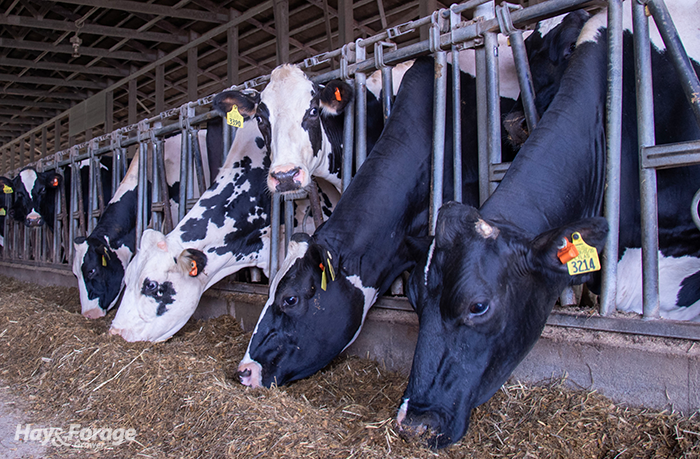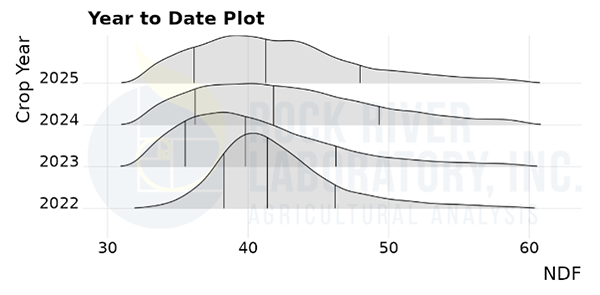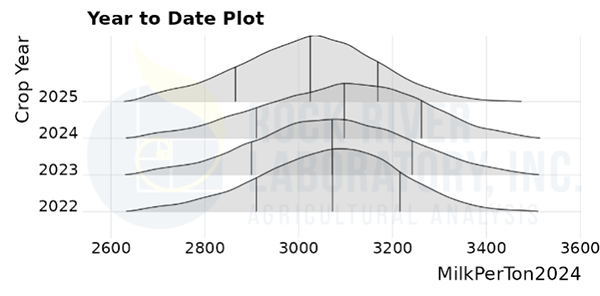
In a recent Hoard’s Dairyman webinar titled “A feed and forage outlook for the year ahead,” Mike Hutjens with the University of Illinois summarized the highs and lows of corn silage and haylage production in 2025 and speculated what might be in store for dairy producers in 2026.
Heat and drought stress defined the end of the growing season across the United States, affecting corn plants from midsummer through harvest. This resulted in higher frequency of tight tassel wrap, reduced cob tip fill, and low stalk integrity, depending on the corn hybrid. Especially in the Midwest, corn exhibited high rates of disease like southern leaf rust and tar spot.
The good news, Hutjens said, is that hay prices and commodity feed prices are currently low. Additionally, market prices for cull cows and beef-on-dairy calves — which now comprise roughly one-third of the Holstein and Jersey calf crop nationwide — are at historic highs, adding a cushion to dwindling milk checks.
Even so, Hutjens suggested the wild cards for dairy producers next year include inflation, milk prices, and commodity markets. He explained how inflation impacts consumer demand for dairy — especially cheese. As the national dairy herd expands and milk production per cow estimates grow, greater total milk yield will likely encourage milk prices to remain low. And a ramp up in biofuel production will influence corn and soybean processing and prices going forward.
Good averages, wide ranges
Hutjens summarized Midwestern corn silage, alfalfa haylage, and mixed haylage quality data from Dairyland Laboratories Inc. Overall, average forage quality for all three feedstuffs was similar to data from the past three years, with little variation in average starch, fiber, and crude protein levels. Hutjens suggested changes seen in average corn silage and haylage moisture levels were due to challenging weather conditions during harvest.
Although average forage quality was on-par with previous years, results from Rock River Laboratory forage analyses show a larger spread in Midwestern haylage samples for quality metrics like neutral detergent fiber (NDF).
“As these curves flatten out, that means there is a lot more variation out there,” Hutjens said. “We have some really high NDF and some modestly low NDF.”

According to Hutjens, corn silage dry matter was within a favorable range despite droughty conditions in mid-August and early September that caused rapid dry down in plants. However, he noted the bell curve for corn silage starch content was slightly behind previous years, likely due to heat stress and a lack of moisture. Considering this data and lower average kernel processing scores, Hutjens said the milk per ton value from Midwestern corn silage was lagging behind last year.

When assessing individual results, Hutjens suggested dairy farmers target forage neutral detergent fiber digestibility after 30 hours (NDFD30) that is more than 50% for legume and grass hay and more than 60% for corn silage. Moreover, undigested neutral detergent fiber after 240 hours (uNDF240) is a quality metric that represents the amount of dry matter a cow can consume before meeting her physical capacity for feed. Hutjens said dairy rations must have more than 7% uNDF240 to maintain optimal rumen function, but less than 12% to avoid underutilization of forage by the cow.
Hutjens also reviewed small grain silage quality data from Rock River Laboratory. Results show a wide range of crude protein levels, which he noted should be between 13% to 15% for good-quality forage. “We are seeing more interest in small grains because of cover crops — rye, triticale, and wheat,” Hutjens said. “Depending on the environment, temperature, and moisture, that quality can change in a matter of 10 days to two weeks, going from good quality to low quality.”
Focus on feed efficiency
To demonstrate the relationship between feed costs, forage quality, and milk production, Hutjens offered a scenario based on Illinois dairy benchmarks in which feed costs were $6.42 per cow per day — or 13 cents per pound of dry matter. That is recently down a penny, thanks to lower alfalfa hay and corn prices. While a penny per pound of dry matter might not seem like much, it adds up quickly when cows eat more than 50 pounds of feed on a dry matter basis, Hutjens said.
He continued to explain that an ideal feed efficiency for cows producing 80 pounds of milk at peak lactation is about 1.5 pounds of energy-corrected milk per pound of dry matter intake. With that said, at 13 cents per pound of dry matter, an uptick from 1.5 to 1.6 in feed efficiency could save farmers 39 cents per head per day.
“Very quickly, we see where we can save 30 to 40 cents, and those are big numbers,” Hutjens said.
Next season’s silage
Looking ahead to the next planting season, Hutjens discussed potential benefits of short corn hybrids coming down the pipeline, including pendulum, semi-upright, and upright types.
“Shorter corn means less wind damage, higher levels of starch, and lower levels of NDF,” Hutjens said. He shared research from Michigan State University that shows short corn hybrids trended higher in NDFD compared to conventional corn, and there was no difference in dry matter intake or feed efficiency between short and tall corn silage. However, short corn will not be a replacement for brown midrib (BMR) corn, which will phase out of the market over the next few years.
“There really is no substitute for BMR corn because BMR corn has lower lignin and more digestible fiber,” Hutjens said.
Overall, forage quality and quantity will be key considerations for dairy production in 2026. Given the wide range of sampling data, Hutjens encouraged farmers to test forage in order to effectively manage for variable quality. Evaluate regional by-product feed values and prices relative to your dairy ration and use the tools available — including advice from nutritionists — to fine-tune animal diets and make the most of existing forage inventories.
